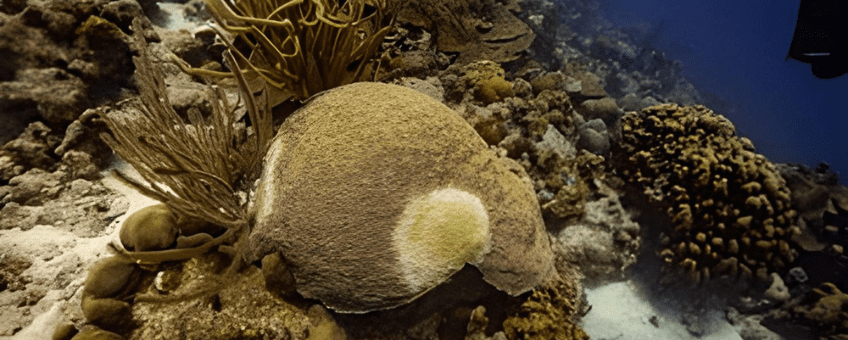
Stony Coral Tissue Loss Disease in the Dutch Caribbean
Dutch Caribbean Nature Alliance (DCNA)Within the Dutch Caribbean, Stony Coral Tissue Loss Disease (SCTLD) has been confirmed now on five of the six islands, starting on St. Maarten in 2018, St. Eustatius in 2019, Saba in 2021 and most recently in Bonaire and Curaçao (March/April 2023). The outbreak of this coral disease may have significant ecological, economic, and social impacts within the Dutch Caribbean. The Dutch Caribbean Nature Alliance (DCNA) urges people to follow the recommendations of the local protected areas management organizations and parks by adhering to the rules, regulations, guidelines for water(sport) users and report sightings to the parks or the Atlantic and Gulf Rapid Reef Assessment Program (AGRRA).
Impacts
Coral reefs are home to many marine life including sponges, crabs, sea turtles, and many species of fish. Coral reefs are also important to people for shoreline protection, tourism, and fisheries. The loss of corals due to this coral disease has significant ecological impacts on the region's marine ecosystem. The disease can cause extensive damage to corals with a negative impact to the entire reef ecosystems. The mortality of corals can lead amongst others to the decline of important fish populations and impact the attraction for recreational tourism. The disease spreads rapidly amongst hard corals but does not affect human health directly.
Response options
Various organizations are working to combat this coral disease by identifying causes and developing management strategies. The disease spreads quickly via the water or direct contact with infected corals. Time is pressing and targeted management actions to try to limit the spread of SCTLD include closing sites, decontaminating dive gear, authorities can treat corals in the water according to best practice methods, and corals can be stored in tanks for future restoration efforts. Existing management strategies that seek to build the resilience of coral reefs to threats such as diseases are now especially important. These include not touching corals, improving water quality, reducing fishing pressure and adhering to ballast water management protocols. In the meanwhile, research will continue.

How to help
Residents and tourists can also help. It is important to always follow the local rules, regulations and guidelines. Make sure to follow along with the local protected areas management organizations (parks)- Fundacion Parke Nacional Aruba , STINAPA Bonaire, CARMABI Curaçao , Saba Conservation Foundation (SCF), St. Eustatius National Parks (STENAPA), Nature Foundation St. Maarten (NFSXM)- to stay up to date on each individual island’s change in conditions, rules, regulations and recommendations for water(sport) users.
Divers are asked to avoid infected dive sites and properly disinfect gear between dives. Please note that for different dive gear there are different recommendations on how to decontaminate. If possible, it is best to limit dives to one site per day and fully dry equipment before re-entering the water. Sightings (photo, location, date) can be reported to the protected areas management organizations or the Atlantic and Gulf Rapid Reef Assessment Program (AGRRA).
More information
- On the AGGRA website you can read more about SCTLD and the distribution in the Caribean.
- Map of SCTLD spread on Bonaire.
- For more information, you can contact:
- Aruba: Fundacion Parke Nacional Aruba
- Bonaire: STINAPA Bonaire
- Curaçao: CARMABI Curaçao
- Saba: Saba Conservation Foundation (SCF)
- St. Eustatius: St. Eustatius National Parks (STENAPA)
- St. Maarten: Nature Foundation St. Maarten (NFSXM)
DCNA
The Dutch Caribbean Nature Alliance (DCNA) supports science communication and outreach in the Dutch Caribbean region by making nature-related scientific information more widely available through amongst others the Dutch Caribbean Biodiversity Database, DCNA’s news platform BioNews and the press. This article contains the results from several scientific studies but the studies themselves are not DCNA studies. No rights can be derived from the content. DCNA is not liable for the content and the in(direct) impacts resulting from publishing this article.
Text: DCNA
Photo: STINAPA Bonaire
